Understanding Dermatology and Racial Disparities in Skin Care
Dermatology, the branch of medicine focusing on the skin, hair, and nails, plays a crucial role in overall health. While often seen as a purely cosmetic field, it is vital for diagnosing various skin conditions that can significantly impact patients’ health.
The Significance of Dermatology
The skin is the body’s largest organ, shedding over a pound of dry skin annually. Dermatologists rely heavily on visual assessments, often making diagnoses based on their familiarity with how conditions present visually.
Key Points:
- Skin Types: Dermatologists use systems like the Fitzpatrick scale, which categorizes skin into types based on pigmentation. Understanding these differences is essential for accurate diagnosis.
- Visual Diagnosis: Many dermatologists can identify common skin diseases just by observing the patient as they enter the room.
The Impact of COVID-19 on Dermatology
During the COVID-19 pandemic, unique skin conditions, including the well-documented "COVID toes," emerged as symptoms. These conditions disproportionately affected communities of color. However, visual documentation of these cases predominantly featured lighter skin tones.
Disparity in Skin Representation:
- Skin Condition Documentation: Studies revealed that up to 92% of images in medical literature represented lighter skin tones (Types 1-3) while darker skin types (5-6) were almost entirely absent.
- Clinical Implications: This lack of representation can lead to misdiagnosis, aggravating health disparities.
Why This Matters
Patients of color can experience notable differences in how skin conditions manifest. For example, psoriasis may appear purple or dark brown on darker skin, contradicting the classic “salmon pink” description common in medical texts.
Additional Effects:
- Health Disparities: Underdiagnosed skin diseases can have severe implications. Conditions like melanoma disproportionately affect patients of color due to later-stage diagnosis, with survival rates significantly lower than their white counterparts.
Influential Voices in Dermatology
Several thought leaders are actively working to address disparities in dermatology.
Dr. Ginette Okoye
- Position: Chair of the Department of Dermatology at Howard University College of Medicine.
- Focus: Advocates for proper representation and diagnosis of skin conditions in people of color, emphasizing a more inclusive approach to skin care.
Dr. Jenna Lester
- Position: Assistant Professor at UCSF.
- Contribution: Co-authored a systematic review revealing the lack of diversity in dermatology imagery. Continues to call for systematic change within the medical community.
Dr. Susan Taylor
- Founder: Created the first skin of color clinic and the Skin of Color Society.
- Mission: Revolutionize dermatological care, pushing for broader representation and education within healthcare.
Solutions for Addressing Disparities
Combatting these issues requires a multifaceted approach:
Actionable Steps:
- Training and Recruitment: More dermatologists from diverse backgrounds should be trained to understand the unique needs of different skin types.
- Diverse Educational Materials: Updating medical textbooks and resources to include a wider variety of skin conditions and types.
- Clinical Trials: More studies focusing specifically on how skin diseases present and affect patients of color.
Conclusion
The field of dermatology has made strides in recognizing racial disparities but still has a long way to go. Improving representation, education, and understanding skin of color is not just essential for clinicians but is crucial for equitable patient care. As new generations of dermatologists emerge, their advocacy and initiatives can continue to advance the field towards inclusivity.
For further reading on dermatology and skin of color, consider checking out the following resources:
By acknowledging these disparities and striving for change, we can foster a more inclusive and effective dermatological practice.


